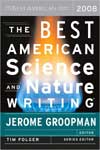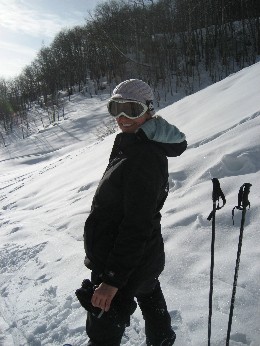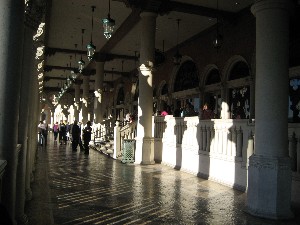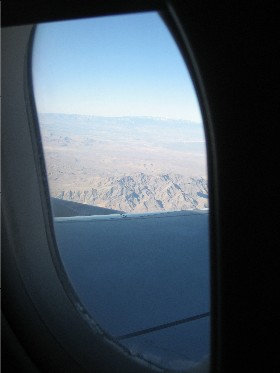 Title: The Best American Science and Nature Writing 2008 // Editor: Jerome Groopman //Publisher: Houghton Mifflin // Date: October 2008 // p. 352
Title: The Best American Science and Nature Writing 2008 // Editor: Jerome Groopman //Publisher: Houghton Mifflin // Date: October 2008 // p. 352
Nature and science buffs, I promise you’ll find something you love about this essay collection. The best of the best, The Best American Science and Nature Writing 2008 lives up to the promise of its title while entertaining readers and posing important questions about the environment, technology, and the future of the planet (in a nutshell, that’s basically it).
The essay I keep thinking about is the book’s final essay, Florence Williams’ “A Mighty Wind.” Originally published in Outside magazine, the essay focuses on the “eco-wonderland” of Samsø, Denmark. This tiny island is the most carbon negative settlement on earth, and Williams’ essay about it read like a celebration of all that is beautiful when communities are united by a common goal. The people of Samsø use enough wind, solar, biofuel and other renewable technologies to sustain themselves completely—and they generate enough excess to share with others. I’ve been thinking about ways to have a more eco-friendly home and office, and this essay expanded my ideas immensely by exposing a future possibility that is also present right here, right now, somewhere on the globe. To read the entire essay, as it appeared in Outside, click here.
And…if you’d like to read my longer, more formal-type review of The Best American Science and Nature Writing 2008, here you go:
The Best American Series is known to corral some of the year’s most exciting writing into a single volume full of rich voices and unique style. The Best American Science and Nature Writing 2008 lives up to this standard with innovative reportage that spans the subjects of biotechnology, linguistics, zoology, and cosmology, among others…click here to continue reading…

 Big smiles here from Vail, Colorado. I’ve recently participated in a local tradition that involves skiing off of Vail Mountain and into the nearby town of Minturn. The Minturn Mile, or simply “The Mile” as locals call it, conveniently ends a short walk from the Minturn Saloon, the perfect spot for an après-ski beverage. Last weekend, it snowed eight inches on Saturday, so my new ski buddy Betsy (below) and I had a great time dropping into the first bowl of fresh powder. There is no official start to The Mile, as it’s technically “out of bounds,” but if you’re on Vail Mountain and you ski in the direction of a run called Lost Boy, you can just keep going straight, and you’ll hit a roped gate. Slide right on through. I’ve also entered The Mile by going towards Vail’s Sun Down Bowl and hiking a bit up a ridge to start by cutting under a rope and dropping down into some nice, steep trees.
Big smiles here from Vail, Colorado. I’ve recently participated in a local tradition that involves skiing off of Vail Mountain and into the nearby town of Minturn. The Minturn Mile, or simply “The Mile” as locals call it, conveniently ends a short walk from the Minturn Saloon, the perfect spot for an après-ski beverage. Last weekend, it snowed eight inches on Saturday, so my new ski buddy Betsy (below) and I had a great time dropping into the first bowl of fresh powder. There is no official start to The Mile, as it’s technically “out of bounds,” but if you’re on Vail Mountain and you ski in the direction of a run called Lost Boy, you can just keep going straight, and you’ll hit a roped gate. Slide right on through. I’ve also entered The Mile by going towards Vail’s Sun Down Bowl and hiking a bit up a ridge to start by cutting under a rope and dropping down into some nice, steep trees. 



 I started reading Richard Todd’s The Thing Itself: On the Search for Authenticity shortly after I returned from a recent weekend trip to Las Vegas. The book helped me process the experience in one of its sections titled “There, There.” While Todd rates the palpability of Vegas slightly better than that of Disney World, he still says Vegas is “…a giant piece of installation art, a gloss on the country, it is not a place at all.” Ouch.
I started reading Richard Todd’s The Thing Itself: On the Search for Authenticity shortly after I returned from a recent weekend trip to Las Vegas. The book helped me process the experience in one of its sections titled “There, There.” While Todd rates the palpability of Vegas slightly better than that of Disney World, he still says Vegas is “…a giant piece of installation art, a gloss on the country, it is not a place at all.” Ouch.

 You can’t take Las Vegas seriously. Isn’t that the point? The U.S. Census Bureau estimates that more that 552,000 people live in Vegas, and surely they’re more in tune with reality, but the rest of us visitors who go there for a weekend don’t expect it. Down a small stretch of paved road, a person can “travel” from Paris to New York to Venice. No kidding though, you know you’re not really anywhere besides the United States, and with just a quick look around, it’s easy to see that this place is American as America gets: people with bad legs wearing shorts, McDonalds lit up with neon lights, waiting in line for shows. The Venetian, with its painted sky and perfumed air, provides perhaps one of the best viewing decks. You can stand up there and people watch. And when the evening light starts to cast long shadows, things start to get kind of beautiful, sparkly.
You can’t take Las Vegas seriously. Isn’t that the point? The U.S. Census Bureau estimates that more that 552,000 people live in Vegas, and surely they’re more in tune with reality, but the rest of us visitors who go there for a weekend don’t expect it. Down a small stretch of paved road, a person can “travel” from Paris to New York to Venice. No kidding though, you know you’re not really anywhere besides the United States, and with just a quick look around, it’s easy to see that this place is American as America gets: people with bad legs wearing shorts, McDonalds lit up with neon lights, waiting in line for shows. The Venetian, with its painted sky and perfumed air, provides perhaps one of the best viewing decks. You can stand up there and people watch. And when the evening light starts to cast long shadows, things start to get kind of beautiful, sparkly. 

 You’re flying into Las Vegas, and you can’t help but wonder: what’s happening here? The plane tilts, rolls. You’re floating over some beautiful open land, and the mellow browns and blues of a desert landscape calm your nerves. Impressive peaks ripple across the dusty earth. Mount Charleston is sprinkled with snow. You’re thinking you didn’t expect the area surrounding Las Vegas to be so impressive, so natural, and then a strange body of turquoise water comes into view: Lake Mead. Its edges have taken the shape of finger-like tentacles digging into its surroundings. Without this water, you know that Vegas—as it is today—couldn’t exist. And knowing this makes you feel kind of creeped out.
You’re flying into Las Vegas, and you can’t help but wonder: what’s happening here? The plane tilts, rolls. You’re floating over some beautiful open land, and the mellow browns and blues of a desert landscape calm your nerves. Impressive peaks ripple across the dusty earth. Mount Charleston is sprinkled with snow. You’re thinking you didn’t expect the area surrounding Las Vegas to be so impressive, so natural, and then a strange body of turquoise water comes into view: Lake Mead. Its edges have taken the shape of finger-like tentacles digging into its surroundings. Without this water, you know that Vegas—as it is today—couldn’t exist. And knowing this makes you feel kind of creeped out. 
 I’m sure there is a lot of debate going on about what will happen to Vegas when the water runs out, but with less snowfall (less snowmelt) and higher temperatures, it’s bound to run dry. Soon.
I’m sure there is a lot of debate going on about what will happen to Vegas when the water runs out, but with less snowfall (less snowmelt) and higher temperatures, it’s bound to run dry. Soon. 
